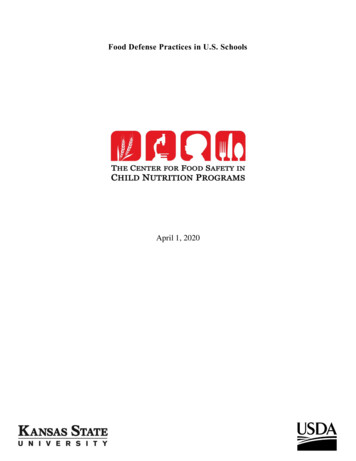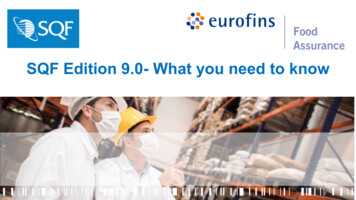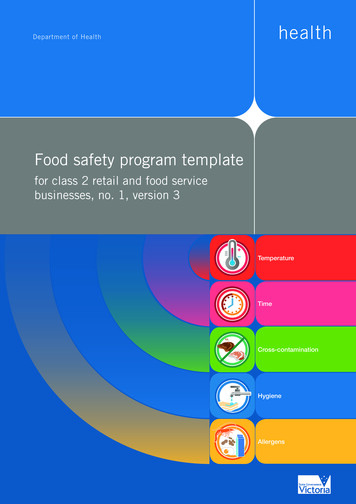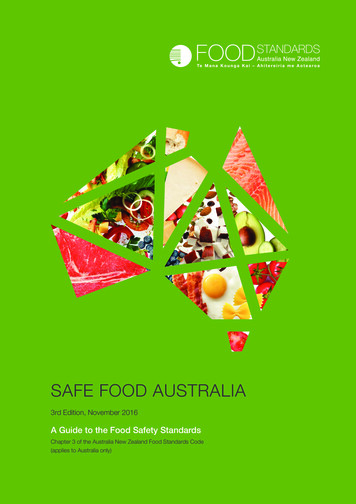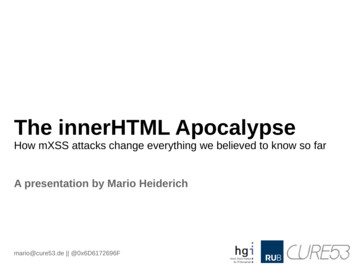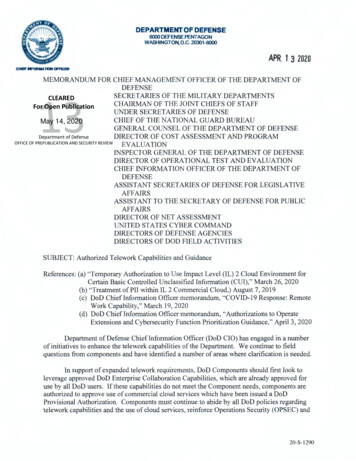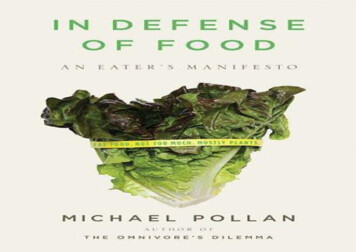
Transcription
IN DEFENSE of FOOD
ALS O BY MICHAE L P OLLANS ec ond NatureA P lac e of M y Ow nThe B otany of Des ireThe Omniv ore’s Dilemma
IN DEFENSE of FOODAN EATER’S MANIFESTOMICHAEL POLLANT HE P E NGUIN P RE S SNew Y ork 2008
T HE P E NGUIN P RE S SP ublis hed by the P enguin GroupP enguin Group (US A ) Inc ., 375 Huds on S treet, New Y ork, New Y ork 10014, U.S .A . P enguin Group (Canada), 90 E glinton A venue E as t, S uite 700, T oronto, Ontario, Canada M4P 2Y 3 (a divis ion of P ears on P enguin Canada Inc .) P enguin B ooks Ltd, 80 S trand, London W C2R ORL, E ngland P enguin Ireland, 25 S t. S tephen’s Green, Dublin 2, Ireland (a divis ion of P enguin B ooks Ltd) P enguin B ooks A us tralia Ltd, 250 Cam berwellRoad, Cam berwell, V ic toria 3124, A us tralia (a divis ion of P ears on A us tralia Group P ty Ltd) P enguin B ooks India P vt Ltd, 11 Com m unity Centre, P anc hs heel P ark, New Delhi-110 017, India P enguin Group (NZ), 67 A pollo Drive, Ros edale, North S hore 0632, New Zealand (a divis ion of P ears on New Zealand Ltd) P enguin B ooks (S outh A fric a) (P ty) Ltd, 24 S turdee A venue, Ros ebank, J ohannes burg 2196, S outh A fric aP enguin B ooks Ltd, Regis tered Offic es :80 S trand, London W C2R ORL, E nglandFirs t publis hed in 2008 by T he P enguin P res s , a m em ber of P enguin Group (US A ) Inc .Copyright Mic hael P ollan, 2008A ll rights res ervedA portion of this book firs t appeared in The New Y ork Times M agaz ine under the title “Unhappy Meals .”LIB RA RY OF CONGRE S S CA T A LOGING IN P UB LICA T ION DA T AP ollan, Mic hael.In defens e of food : an eater’s m anifes to / Mic hael P ollan.p. c m .Inc ludes bibliographic al referenc es and index.IS B N: 1-4295-8125-51. Nutrition. 2. Food habits . I. T itle.RA 784.P 643 2008613— dc 222007037552W ithout lim iting the rights under c opyright res erved above, no part of this public ation m ay be reproduc ed, s tored in or introduc ed into a retrieval s ys tem , or trans m itted, in any form or by any m eans (elec tronic , m ec hanic al, photoc opying, rec ording or otherwis e), without the prior written perm is s ion of both the c opyright owner and the above publis her of this book.T he s c anning, uploading, and dis tribution of this book via the Internet or via any other m eans without the perm is s ion of the publis her is illegal and punis hable by law. P leas e purc has e only authorized elec tronic editions and do not partic ipate in or enc ourage elec tronic pirac y of c opyrightable m aterials . Y our s upport of the author’s rights is apprec iated.
FOR ANN AND GE RRY ,W ith gratitude for y our loy al friends hipand ins pired editing
CONTENTSAn Eater’s ManifestoINTRODUCTIONI THE AGE OF NUTRITIONISMONEFrom Foods to NutrientsTW ONutritionism DefinedNutritionism Comes to MarketTHRE EFood Science’s Golden AgeFOURThe Melting of the Lipid HypothesisFIV ES IXEat Right, Get FatterSEVENThe Proof in the Low-Fat PuddingE IGHTBad ScienceNINETE NBeyond the Pleasure PrincipleNutritionism’s ChildrenII THE WESTERN DIET AND THE DISEASES OF CIVILIZATIONONEThe Aborigine in All of UsTW OThe Elephant in the RoomTHRE EThe Industrialization of Eating: What We Do Know1) From Whole Foods to Refined2) From Complexity to Simplicity3) From Quality to Quantity4) From Leaves to Seeds5) From Food Culture to Food Science
III GETTING OVER NUTRITIONISMONEEscape from the Western DietTW OEat Food: Food DefinedTHRE EFOURMostly Plants: What to EatNot Too Much: How to EatACKNOW LE DGME NTSS OURCE SRE S OURCE SINDE X
IN DEFENSE of FOOD
INTRODUCTIONAN EATER’S MANIFESTOEat food. Not too much. Mostly plants.That, more or less, is the short answer to the supposedly incredibly complicated and confusing question of what we humans should eat in order to be maximally healthy.I hate to give the game away right here at the beginning of a whole book devoted to the subject, and I’m tempted to complicate matters in the interest of keeping things going for a couple hundredmore pages or so. I’ll try to resist, but will go ahead and add a few more details to flesh out the recommendations. Like, eating a little meat isn’t going to kill you, though it might be better approached as aside dish than as a main. And you’re better off eating whole fresh foods rather than processed food products. That’s what I mean by the recommendation to “eat food,” which is not quite as simple as itsounds. For while it used to be that food was all you could eat, today there are thousands of other edible foodlike substances in the supermarket. These novel products of food science often come inpackages elaborately festooned with health claims, which brings me to another, somewhat counterintuitive, piece of advice: If you’re concerned about your health, you should probably avoid products thatmake health claims. Why? Because a health claim on a food product is a strong indication it’s not really food, and food is what you want to eat.You can see how quickly things can get complicated.I started on this quest to identify a few simple rules about eating after publishing The Omnivore’s Dilemma in 2006. Questions of personal health did not take center stage in that book, which wasmore concerned with the ecological and ethical dimensions of our eating choices. (Though I’ve found that, in most but not all cases, the best ethical and environmental choices also happen to be the bestchoices for our health—very good news indeed.) But many readers wanted to know, after they’d spent a few hundred pages following me following the food chains that feed us, “Okay, but what should Ieat? And now that you’ve been to the feedlots, the food-processing plants, the organic factory farms, and the local farms and ranches, what do you eat?”Fair questions, though it does seem to me a symptom of our present confusion about food that people would feel the need to consult a journalist, or for that matter a nutritionist or doctor or governmentfood pyramid, on so basic a question about the conduct of our everyday lives as humans. I mean, what other animal needs professional help in deciding what it should eat? True, as omnivores—creaturesthat can eat just about anything nature has to offer and that in fact need to eat a wide variety of different things in order to be healthy—the “What to eat” question is somewhat more complicated for us thanit is for, say, cows. Yet for most of human history, humans have navigated the question without expert advice. To guide us we had, instead, Culture, which, at least when it comes to food, is really just afancy word for your mother. What to eat, how much of it to eat, what order in which to eat it, with what and when and with whom have for most of human history been a set of questions long settled andpassed down from parents to children without a lot of controversy or fuss.But over the last several decades, mom lost much of her authority over the dinner menu, ceding it to scientists and food marketers (often an unhealthy alliance of the two) and, to a lesser extent, to thegovernment, with its ever-shifting dietary guidelines, food-labeling rules, and perplexing pyramids. Think about it: Most of us no longer eat what our mothers ate as children or, for that matter, what ourmothers fed us as children. This is, historically speaking, an unusual state of affairs.My own mother grew up in the 1930s and 1940s eating a lot of traditional Jewish-American fare, typical of families who recently emigrated from Russia or Eastern Europe: stuffed cabbage, organmeats, cheese blintzes, kreplach, knishes stuffed with potato or chicken liver, and vegetables that often were cooked in rendered chicken or duck fat. I never ate any of that stuff as a kid, except when Ivisited my grandparents. My mother, an excellent and adventurous cook whose own menus were shaped by the cosmopolitan food trends of New York in the 1960s (her influences would have included the1964 World’s Fair; Julia Child and Craig Claiborne; Manhattan restaurant menus of the time; and of course the rising drumbeat of food marketing) served us a rotating menu that each week completed aculinary world tour: beouf bourguignon or beef Stroganoff on Monday; coq au vin or oven-fried chicken (in a Kellogg’s Cornflakes crust) on Tuesday; meat loaf or Chinese pepper steak on Wednesday(yes, there was a lot of beef); spaghetti pomodoro with Italian sausages on Thursday; and on her weekend nights off, a Swanson’s TV dinner or Chinese takeout. She cooked with Crisco or Wesson oilrather than chicken or duck fat and used margarine rather than butter because she’d absorbed the nutritional orthodoxy of the time, which held that these more up-to-date fats were better for our health.
(Oops.)Nowadays I don’t eat any of that stuff—and neither does my mother, who has moved on too. Her parents wouldn’t recognize the foods we put on the table, except maybe the butter, which is back.Today in America the culture of food is changing more than once a generation, which is historically unprecedented—and dizzying.What is driving such relentless change in the American diet? One force is a thirty-two-billion-dollar food-marketing machine that thrives on change for its own sake. Another is the constantly shiftingground of nutrition science that, depending on your point of view, is steadily advancing the frontiers of our knowledge about diet and health or is just changing its mind a lot because it is a flawed sciencethat knows much less than it cares to admit. Part of what drove my grandparents’ food culture from the American table was official scientific opinion, which, beginning in the 1960s, decided that animal fatwas a deadly substance. And then there were the food manufacturers, which stood to make very little money from my grandmother’s cooking, because she was doing so much of it from scratch—up to andincluding rendering her own cooking fats. Amplifying the “latest science,” they managed to sell her daughter on the virtues of hydrogenated vegetable oils, the ones that we’re now learning may be, well,deadly substances.Sooner or later, everything solid we’ve been told about the links between our diet and our health seems to get blown away in the gust of the most recent study. Consider the latest findings. In 2006came news that a low-fat diet, long believed to protect against cancer, may do no such thing—this from the massive, federally funded Women’s Health Initiative, which has also failed to find a link betweena low-fat diet and the risk of coronary heart disease. Indeed, the whole nutritional orthodoxy around dietary fat appears to be crumbling, as we will see. In 2005 we learned that dietary fiber might not, aswe’d been confidently told for years, help prevent colorectal cancers and heart disease. And then, in the fall of 2006, two prestigious studies on omega-3 fats published at the same time came to strikinglydifferent conclusions. While the Institute of Medicine at the National Academy of Sciences found little conclusive evidence that eating fish would do your heart much good (and might hurt your brain,because so much fish is contaminated with mercury), a Harvard study brought the hopeful piece of news that simply by eating a couple of servings of fish each week (or by downing enough fish oil tablets)you could cut your risk of dying from a heart attack by more than a third. It’s no wonder that omega-3 fatty acids are poised to become the oat bran of our time as food scientists rush to microencapsulatefish and algae oil and blast it into such formerly all-terrestrial foods as bread and pasta, milk and yogurt and cheese, all of which will soon, you can be sure, spout fishy new health claims. (I hope youremember the relevant rule.)By now you’re probably feeling the cognitive dissonance of the supermarket shopper or science-section reader as well as some nostalgia for the simplicity and solidity of the first few words of thisbook. Words I’m still prepared to defend against the shifting winds of nutritional science and food-industry marketing, and will. But before I do, it’s important to understand how we arrived at our presentstate of nutritional confusion and anxiety. That is the subject of the first portion of this book, “The Age of Nutritionism.”The story of how the most basic questions about what to eat ever got so complicated reveals a great deal about the institutional imperatives of the food industry, nutrition science, and—ahem—journalism, three parties that stand to gain much from widespread confusion surrounding the most elemental question an omnivore confronts. But humans deciding what to eat without professionalguidance—something they have been doing with notable success since coming down out of the trees—is seriously unprofitable if you’re a food company, a definite career loser if you’re a nutritionist, andjust plain boring if you’re a newspaper editor or reporter. (Or, for that matter, an eater. Who wants to hear, yet again, that you should “eat more fruits and vegetables”?) And so like a large gray cloud, agreat Conspiracy of Scientific Complexity has gathered around the simplest questions of nutrition—much to the advantage of everyone involved. Except perhaps the supposed beneficiary of all thisnutritional advice: us, and our health and happiness as eaters. For the most important thing to know about the campaign to professionalize dietary advice is that it has not made us any healthier. To thecontrary: As I argue in part one, most of the nutritional advice we’ve received over the last half century (and in particular the advice to replace the fats in our diets with carbohydrates) has actually made usless healthy and considerably fatter.My aim in this book is to help us reclaim our health and happiness as eaters. To do this requires an exercise that might at first blush seem unnecessary, if not absurd: to offer a defense of food andthe eating thereof. That food and eating stand in need of a defense might seem counterintuitive at a time when “overnutrition” is emerging as a more serious threat to public health than undernutrition. But Icontend that most of what we’re consuming today is no longer, strictly speaking, food at all, and how we’re consuming it—in the car, in front of the TV, and, increasingly, alone—is not really eating, at leastnot in the sense that civilization has long understood the term. Jean-Anthelme Brillat-Savarin, the eighteenth-century gastronomist, drew a useful distinction between the alimentary activity of animals, which“feed,” and humans, who eat, or dine, a practice, he suggested, that owes as much to culture as it does to biology.But if food and eating stand in need of a defense, from whom, or what, do they need defending? From nutrition science on one side and from the food industry on the other—and from the needlesscomplications around eating that together they have fostered. As eaters we find ourselves increasingly in the grip of a Nutritional Industrial Complex—comprised of well-meaning, if error-prone, scientistsand food marketers only too eager to exploit every shift in the nutritional consensus. Together, and with some crucial help from the government, they have constructed an ideology of nutritionism that,among other things, has convinced us of three pernicious myths: that what matters most is not the food but the “nutrient”; that because nutrients are invisible and incomprehensible to everyone butscientists, we need expert help in deciding what to eat; and that the purpose of eating is to promote a narrow concept of physical health. Because food in this view is foremost a matter of biology, it followsthat we must try to eat “scientifically”—by the nutrient and the number and under the guidance of experts.If such an approach to food doesn’t strike you as the least bit strange, that is probably because nutritionist thinking has become so pervasive as to be invisible. We forget that, historically, people haveeaten for a great many reasons other than biological necessity. Food is also about pleasure, about community, about family and spirituality, about our relationship to the natural world, and aboutexpressing our identity. As long as humans have been taking meals together, eating has been as much about culture as it has been about biology.That eating should be foremost about bodily health is a relatively new and, I think, destructive idea—destructive not just of the pleasure of eating, which would be bad enough, but paradoxically of our
health as well. Indeed, no people on earth worry more about the health consequences of their food choices than we Americans do—and no people suffer from as many diet-related health problems. Weare becoming a nation of orthorexics: people with an unhealthy obsession with healthy eating.*The scientists haven’t tested the hypothesis yet, but I’m willing to bet that when they do they’ll find an inverse correlation between the amount of time people spend worrying about nutrition and theiroverall health and happiness. This is, after all, the implicit lesson of the French paradox, so-called not by the French (Quel paradoxe?) but by American nutritionists, who can’t fathom how a people whoenjoy their food as much as the French do, and blithely eat so many nutrients deemed toxic by nutritionists, could have substantially lower rates of heart disease than we do on our elaborately engineeredlow-fat diets. Maybe it’s time we confronted the American paradox: a notably unhealthy population preoccupied with nutrition and diet and the idea of eating healthily.I don’t mean to suggest that all would be well if we could just stop worrying about food or the state of our dietary health: Let them eat Twinkies! There are in fact some very good reasons to worry. The riseof nutritionism reflects legitimate concerns that the American diet, which is well on its way to becoming the world’s diet, has changed in ways that are making us increasingly sick and fat. Four of the topten causes of death today are chronic diseases with well-established links to diet: coronary heart disease, diabetes, stroke, and cancer. Yes, the rise to prominence of these chronic diseases is partly dueto the fact that we’re not dying earlier in life of infectious diseases, but only partly: Even after adjusting for age, many of the so-called diseases of civilization were far less common a century ago—and theyremain rare in places where people don’t eat the way we do.I’m speaking, of course, of the elephant in the room whenever we discuss diet and health: “the Western diet.” This is the subject of the second part of the book, in which I follow the story of the mostradical change to the way humans eat since the discovery of agriculture. All of our uncertainties about nutrition should not obscure the plain fact that the chronic diseases that now kill most of us can betraced directly to the industrialization of our food: the rise of highly processed foods and refined grains; the use of chemicals to raise plants and animals in huge monocultures; the superabundance ofcheap calories of sugar and fat produced by modern agriculture; and the narrowing of the biological diversity of the human diet to a tiny handful of staple crops, notably wheat, corn, and soy. Thesechanges have given us the Western diet that we take for granted: lots of processed foods and meat, lots of added fat and sugar, lots of everything—except vegetables, fruits, and whole grains.That such a diet makes people sick and fat we have known for a long time. Early in the twentieth century, an intrepid group of doctors and medical workers stationed overseas observed that whereverin the world people gave up their traditional way of eating and adopted the Western diet, there soon followed a predictable series of Western diseases, including obesity, diabetes, cardiovasculardiseases, and cancer. They called these the Western diseases and, though the precise causal mechanisms were (and remain) uncertain, these observers had little doubt these chronic diseases shared acommon etiology: the Western diet.What’s more, the traditional diets that the new Western foods displaced were strikingly diverse: Various populations thrived on diets that were what we’d call high fat, low fat, or high carb; all meat orall plant; indeed, there have been traditional diets based on just about any kind of whole food you can imagine. What this suggests is that the human animal is well adapted to a great many different diets.The Western diet, however, is not one of them.Here, then, is a simple but crucial fact about diet and health, yet, curiously, it is a fact that nutritionism cannot see, probably because it developed in tandem with the industrialization of our food and sotakes it for granted. Nutritionism prefers to tinker with the Western diet, adjusting the various nutrients (lowering the fat, boosting the protein) and fortifying processed foods rather than questioning theirvalue in the first place. Nutritionism is, in a sense, the official ideology of the Western diet and so cannot be expected to raise radical or searching questions about it.But we can. By gaining a firmer grasp on the nature of the Western diet—trying to understand it not only physiologically but also historically and ecologically—we can begin to develop a different wayof thinking about food that might point a path out of our predicament. In doing so we have two sturdy—and strikingly hopeful—facts to guide us: first, that humans historically have been healthy eating agreat many different diets; and second, that, as we’ll see, most of the damage to our food and health caused by the industrialization of our eating can be reversed. Put simply, we can escape the Westerndiet and its consequences.This is the burden of the third and last section of In Defense of Food: to propose a couple dozen personal rules of eating that are conducive not only to better health but also to greater pleasure ineating, two goals that turn out to be mutually reinforcing.These recommendations are a little different from the dietary guidelines you’re probably accustomed to. They are not, for example, narrowly prescriptive. I’m not interested in telling you what to havefor dinner. No, these suggestions are more like eating algorithms, mental devices for thinking through our food choices. Because there is no single answer to the question of what to eat, these guidelineswill produce as many different menus as there are people using them.These rules of thumb are also not framed in the vocabulary of nutrition science. This is not because nutrition science has nothing important to teach us—it does, at least when it avoids the pitfalls ofreductionism and overconfidence—but because I believe we have as much, if not more, to learn about eating from history and culture and tradition. We are accustomed in all matters having to do withhealth to assuming science should have the last word, but in the case of eating, other sources of knowledge and ways of knowing can be just as powerful, sometimes more so. And while I inevitably rely onscience (even reductionist science) in attempting to understand many questions about food and health, one of my aims in this book is to show the limitations of a strictly scientific understanding ofsomething as richly complex and multifaceted as food. Science has much of value to teach us about food, and perhaps someday scientists will “solve” the problem of diet, creating the nutritionally optimalmeal in a pill, but for now and the foreseeable future, letting the scientists decide the menu would be a mistake. They simply do not know enough.
You may well, and rightly, wonder who am I to tell you how to eat? Here I am advising you to reject the advice of science and industry—and then blithely go on to offer my own advice. So on whoseauthority do I purport to speak? I speak mainly on the authority of tradition and common sense. Most of what we need to know about how to eat we already know, or once did until we allowed the nutritionexperts and the advertisers to shake our confidence in common sense, tradition, the testimony of our senses, and the wisdom of our mothers and grandmothers.Not that we had much choice in the matter. By the 1960s or so it had become all but impossible to sustain traditional ways of eating in the face of the industrialization of our food. If you wanted to eatproduce grown without synthetic chemicals or meat raised on pasture without pharmaceuticals, you were out of luck. The supermarket had become the only place to buy food, and real food was rapidlydisappearing from its shelves, to be replaced by the modern cornucopia of highly processed foodlike products. And because so many of these novelties deliberately lied to our senses with fakesweeteners and flavorings, we could no longer rely on taste or smell to know what we were eating.Most of my suggestions come down to strategies for escaping the Western diet, but before the resurgence of farmers’ markets, the rise of the organic movement, and the renaissance of localagriculture now under way across the country, stepping outside the conventional food system simply was not a realistic option for most people. Now it is. We are entering a postindustrial era of food; forthe first time in a generation it is possible to leave behind the Western diet without having also to leave behind civilization. And the more eaters who vote with their forks for a different kind of food, themore commonplace and accessible such food will become. Among other things, this book is an eater’s manifesto, an invitation to join the movement that is renovating our food system in the name ofhealth—health in the very broadest sense of that word.I doubt the last third of this book could have been written forty years ago, if only because there would have been no way to eat the way I propose without going back to the land and growing all yourown food. It would have been the manifesto of a crackpot. There was really only one kind of food on the national menu, and that was whatever industry and nutritionism happened to be serving. Notanymore. Eaters have real choices now, and those choices have real consequences, for our health and the health of the land and the health of our food culture—all of which, as we will see, are inextricablylinked. That anyone should need to write a book advising people to “eat food” could be taken as a measure of our alienation and confusion. Or we can choose to see it in a more positive light and countourselves fortunate indeed that there is once again real food for us to eat.
ITHE AGE OF NUTRITIONISM
ONE FROM FOODS TO NUTRIENTSIf you spent any time at all in a supermarket in the 1980s, you might have noticed something peculiar going on. The food was gradually disappearing from the shelves. Not literally vanishing—I’m nottalking about Soviet-style shortages. No, the shelves and refrigerated cases still groaned with packages and boxes and bags of various edibles, more of them landing every year in fact, but a great manyof the traditional supermarket foods were steadily being replaced by “nutrients,” which are not the same thing. Where once the familiar names of recognizable comestibles—things like eggs or breakfastcereals or snack foods—claimed pride of place on the brightly colored packages crowding the aisles, now new, scientific-sounding terms like “cholesterol” and “fiber” and “saturated fat” began rising tolarge-type prominence. More important than mere foods, the presence or absence of these invisible substances was now generally believed to confer health benefits on their eaters. The implicit messagewas that foods, by comparison, were coarse, old-fashioned, and decidedly unscientific things—who could say what was in them really? But nutrients—those chemical compounds and minerals in foodsthat scientists have identified as important to our health—gleamed with the promise of scientific certainty. Eat more of the right ones, fewer of the wrong, and you would live longer, avoid chronic diseases,and lose weight.Nutrients themselves had been around as a concept and a set of words since early in the nineteenth century. That was when William Prout, an English doctor and chemist, identified the three principalconstituents of food—protein, fat, and carbohydrates—that would come to be known as macronutrients. Building on Prout’s discovery, Justus von Liebig, the great German scientist credited as one of thefounders of organic chemistry, added a couple of minerals to the big three and declared that the mystery of animal nutrition—how food turns into flesh and energy—had been solved. This is the very sameLiebig who identified the macronutrients in soil—nitrogen, phosphorus, and potassium (known to farmers and gardeners by their periodic table initials, N, P, and K). Liebig claimed that all that plants needto live and grow are these three chemicals, period. As with the plant, so with the person: In 1842, Liebig proposed a theory of metabolism that explained life strictly in terms of a small handful of chemicalnutrients, without recourse to metaphysical forces such as “vitalism.”Having cracked the mystery of human nutrition, Liebig went on to develop a meat extract—Liebig’s Extractum Carnis—that has come down to us as bouillon and concocted the first baby formula,consisting of cow’s milk, wheat flour, malted flour, and potassium bicarbonate.Liebig, the father of modern nutritional science, had driven food into a corner and forced it to yield its chemical secrets. But the post–Liebig consensus that science now pretty much knew what wasgoing on in food didn’t last long. Doctors began to notice that many of the babies fed exclusively on Liebig’s formula failed to thrive. (Not surprising, given that his preparation lacked any vitamins orseveral essential fats and amino acids.) That Liebig might have overlooked a few little things in food also began to occur to doctors who observed that sailors on long ocean voyages often got sick, evenwhen they had adequa
IN DEFENSE of FOOD. INTRODUCTION AN EATER’S MANIFESTO Eat food. Not too much. Mostly plants. That, more or less, is the short answer to the supposedly incredibly complicated and confusing question of wh
